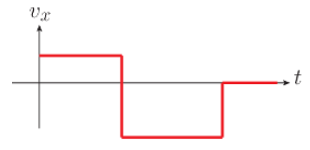
College Physics
11th Edition
ISBN: 9781305952300
Author: Raymond A. Serway, Chris Vuille
Publisher: Cengage Learning
expand_more
expand_more
format_list_bulleted
Concept explainers
Question
thumb_up100%
Consider the graph of velocity versus time shown in the figure for an object undergoing one-dimensional motion. What would the position versus time graph look like for this graph?

Transcribed Image Text:Vx
Expert Solution
This question has been solved!
Explore an expertly crafted, step-by-step solution for a thorough understanding of key concepts.
This is a popular solution
Trending nowThis is a popular solution!
Step by stepSolved in 3 steps with 3 images

Knowledge Booster
Learn more about
Need a deep-dive on the concept behind this application? Look no further. Learn more about this topic, physics and related others by exploring similar questions and additional content below.Similar questions
- The graph at right shows velocity vs. time. The particle at t=0 was positioned at Xo = 15. What is the position, velocity and acceleration at t=8.0 s? v, (m/s) 10 5 0 -5 -10- 2 4 6 8 -1 (s) 10 12arrow_forwardEmmy is standing on a moving sidewalk traveling with an initial velocity of +2 m/s when she experiences some acceleration over the 5 s time period, as shown in the image. Sketch a graph of emmy's velocity over this same time period. Acceleration over time graph is provided below.arrow_forwardA little girl accidentally drops a 62 kg object from her balcony. This balcony has a height of 493 feet. 1.)How long will it take the object to hit the pavement? 2.)Sketch a graph of the displacement of the object as a function of time.arrow_forward
- On a speed-time graph, what is the acceleration during the interval if the velocity changes from 20 m/s to 500 m/s in 6 s?arrow_forwardThe figure below shows a position vs. time graph of a certain object. Which statements about the object's motion are true for the period of time shown in the graph? (more than one answer may apply) The initial velocity is negative The initial velocity is zero The initial velocity is positive The acceleration is negative The acceleration is zero The acceleration is positivearrow_forwardThe diagram represents the acceleration versus time graph of an object. Which statement is true about the motion of the object? (m-s-2) a t (s) The object is moving with constant non-zero acceleration. The object is moving a constant velocity. The object is at rest. None of the choices provided.arrow_forward
- An object moves along a straight line. The graph shows the position of the object as a function of time. Which of the segments of the graph does the object have a decreasing average speed with respect to time?arrow_forwardIf a ball is thrown straight up into the air, what is its acceleration as it moves upward? How do I figure this out? it is asking for m/sarrow_forwardA car moves to the right at constant acceleration, starting from rest. In the figure the position of the car is shown at 1.1 s time intervals, and the tick marks on the x-axis are a distance 3.6 m apart. What is the acceleration of the car, in meters per second squared?arrow_forward
- Sketch a velocity vs time graph of an object that is released from rest and then reaches termainal velocity. Be sure to label each coordinate axis.arrow_forwardHaley is driving down a straight highway at 67 mph. A construction sign warns that the speed limit will drop to 55 mph in 0.50 mi. What constant acceleration (in m/s2) will bring Haley to this lower speed in the distance available? Express your answer in meters per second squared.arrow_forwardFrom physics how do we calculate the formula sheetarrow_forward
arrow_back_ios
SEE MORE QUESTIONS
arrow_forward_ios
Recommended textbooks for you
 College PhysicsPhysicsISBN:9781305952300Author:Raymond A. Serway, Chris VuillePublisher:Cengage Learning
College PhysicsPhysicsISBN:9781305952300Author:Raymond A. Serway, Chris VuillePublisher:Cengage Learning University Physics (14th Edition)PhysicsISBN:9780133969290Author:Hugh D. Young, Roger A. FreedmanPublisher:PEARSON
University Physics (14th Edition)PhysicsISBN:9780133969290Author:Hugh D. Young, Roger A. FreedmanPublisher:PEARSON Introduction To Quantum MechanicsPhysicsISBN:9781107189638Author:Griffiths, David J., Schroeter, Darrell F.Publisher:Cambridge University Press
Introduction To Quantum MechanicsPhysicsISBN:9781107189638Author:Griffiths, David J., Schroeter, Darrell F.Publisher:Cambridge University Press Physics for Scientists and EngineersPhysicsISBN:9781337553278Author:Raymond A. Serway, John W. JewettPublisher:Cengage Learning
Physics for Scientists and EngineersPhysicsISBN:9781337553278Author:Raymond A. Serway, John W. JewettPublisher:Cengage Learning Lecture- Tutorials for Introductory AstronomyPhysicsISBN:9780321820464Author:Edward E. Prather, Tim P. Slater, Jeff P. Adams, Gina BrissendenPublisher:Addison-Wesley
Lecture- Tutorials for Introductory AstronomyPhysicsISBN:9780321820464Author:Edward E. Prather, Tim P. Slater, Jeff P. Adams, Gina BrissendenPublisher:Addison-Wesley College Physics: A Strategic Approach (4th Editio...PhysicsISBN:9780134609034Author:Randall D. Knight (Professor Emeritus), Brian Jones, Stuart FieldPublisher:PEARSON
College Physics: A Strategic Approach (4th Editio...PhysicsISBN:9780134609034Author:Randall D. Knight (Professor Emeritus), Brian Jones, Stuart FieldPublisher:PEARSON

College Physics
Physics
ISBN:9781305952300
Author:Raymond A. Serway, Chris Vuille
Publisher:Cengage Learning

University Physics (14th Edition)
Physics
ISBN:9780133969290
Author:Hugh D. Young, Roger A. Freedman
Publisher:PEARSON

Introduction To Quantum Mechanics
Physics
ISBN:9781107189638
Author:Griffiths, David J., Schroeter, Darrell F.
Publisher:Cambridge University Press

Physics for Scientists and Engineers
Physics
ISBN:9781337553278
Author:Raymond A. Serway, John W. Jewett
Publisher:Cengage Learning

Lecture- Tutorials for Introductory Astronomy
Physics
ISBN:9780321820464
Author:Edward E. Prather, Tim P. Slater, Jeff P. Adams, Gina Brissenden
Publisher:Addison-Wesley

College Physics: A Strategic Approach (4th Editio...
Physics
ISBN:9780134609034
Author:Randall D. Knight (Professor Emeritus), Brian Jones, Stuart Field
Publisher:PEARSON